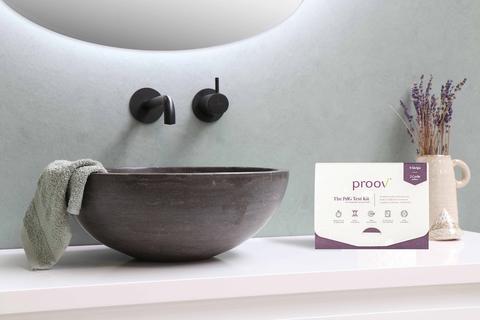The following article is sponsored by our friends at Proov.
When a woman is finally ready for a baby, there’s a particular bodily function that becomes really important to her, to which she may never have given a second thought beforehand: ovulation. In fact, when many women quit the pill in anticipation of getting pregnant, they eagerly await the day when they will ovulate again. “Signs of ovulation after stopping the pill,” “how to force ovulation,” and “how soon can you get pregnant after stopping the pill,” are just a few of the ovulation-related Google searches that collectively garner over 10,000 hits a month.
But you don’t have to be trying to conceive to care about ovulation health; in fact, you should attend to your ovulation health well before you’re even beginning to think about a baby! Thankfully, there is an easy-to-use-at-home technology that can help you do just that: Proov PdG test strips.
Learning some “ovulation appreciation”
Knowing whether you are ovulating, or, conversely, not ovulating, can give you important clues to your overall health—and help you get proper medical attention if you need it. And for the growing number of women who are ditching the pill in favor of more natural methods of family planning like fertility awareness, this “ovulation appreciation” naturally exists even when one isn’t necessarily trying to get pregnant.
But how does one confirm they are ovulating? And is it possible to determine if you are ovulating well? Different methods of fertility awareness rely on different biomarkers to help women approximate or confirm ovulation. For example, the Sympto-Thermal Method (STM) of fertility awareness (also often called natural family planning) relies on the telltale rise in basal body temperature to confirm ovulation. Sympto-Hormonal Methods like Marquette and FEMM rely on readouts from hormone monitors or test strips to let a user know that they have likely ovulated.
However, when using a FAM, you may be ovulating—and seeing evidence of it in your cycle charts—but if the empty follicle from which your egg came (now called the corpus luteum), is not producing a sufficient enough amount of progesterone post-ovulation, it can manifest itself in a number of physical ways, including menstrual health issues and infertility. A healthy level of post-ovulation progesterone is essential for good reproductive health and fertility, but you may not know if your progesterone is peaking and staying elevated as it should—even if you are ovulating and menstruating regularly, and charting your cycle through a FAM—sans help from a knowledgeable medical provider and diagnostic tests. Proov PdG strips can be an easy first step, taken at home, allowing you to get a better idea about the quality of your ovulation, which can lead to more informed reproductive medical care if needed.
Using Proov to confirm ovulation
Proov test strips measure PdG, a metabolite of progesterone found in the urine. Progesterone, of course, surges during the second half of one’s cycle after ovulation has occurred—at least, that’s what’s supposed to happen!
Proov test strips are not the same as ovulation predictor strips, which measure the surge in LH that typically precedes or coincides with ovulation, but rather, they actually confirm that ovulation has already happened. They also confirm the quality of ovulation, by making sure that PdG levels not only rise, but stay appropriately elevated long enough to indicate that your body is ovulating well.
Whether you are trying to get pregnant or not, this ovulation information can be incredibly valuable for any woman to have. One Proov user, Johanna, explains how she is using Proov tests to proactively advocate for her good health:
“I started using @proovtest last cycle and found out my ovulation quality was pretty low. I had suspected this was the case because of my PMS symptoms (which in itself is an indication of hormone imbalances). But seeing only one positive out of the four I needed was the kick in the butt I needed to finally schedule an appointment with a medical provider. After meeting with the provider last week, we were able to see that my Vitamin D is low and that my triglycerides are high (which may indicate insulin resistance). Now I have an appointment for more labs to get to the bottom of my less than ideal ovulation. And it’s all thanks to Proov!
Ovulation is the “fifth vital sign”
There are many more testimonies just like Johanna’s available at proovtest.com, which indicates that many women are waking up to the reality of the importance of ovulation for more than just pregnancy achievement. And fortunately, many more doctors are recognizing that healthy ovulation (and therefore a healthy cycle) is truly a woman’s “fifth vital sign.” These doctors, who are trained to read women’s cycle charts and the information gathered through fertility monitors, Proov test strips, and other Femtech products, know how to get women the help they need to have healthy cycles, without resorting to the quick-fix of hormonal birth control.
Women need to ovulate, and they need to ovulate well, in order to be as healthy as they possibly can be. It’s as simple as that. Simple technologies like Proov give women the power to take ownership of this important aspect of their health.







